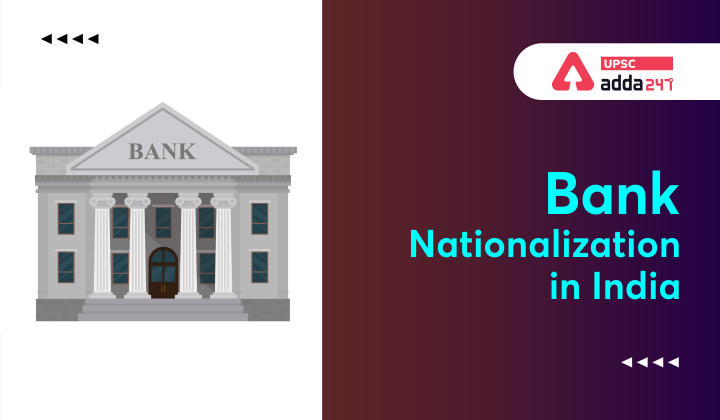Table of Contents
What is nationalisation of banks?
- Bank nationalisation can be expressed as a process whereby the national or state government is empowered to take over the private industry, organization or even the assets in their hands, which is often called public ownership, through any legislation.
Process of bank nationalisation
- In India, bank nationalisation was started after the government enacted the RBI (Transfer of public ownership) Act in order to nationalize the Reserve Bank of India.
- Consequently, on Jan 1st, 1949, RBI was nationalized.
- Similarly, in 1955, the Imperial Bank of India underwent nationalization and later it was named as the State Bank of India which, in the present time, is the largest public sector bank and a D-SIB (Domestic Systematically Important Bank).
- 14 bank nationalisation: Then in the year 1969, 14 of the major commercial banks that were functioning in India, underwent nationalization.
- Bank nationalisation in 1980: In 1980, another 6 banks were nationalized which increased the total number nationalised banks to 20.

Bank nationalisation: Why needed?
- Wars with China (1962) and Pakistan (1965) put immense pressure on public exchequer.
- Two successive years of drought had led to severe food shortages and also compromised national security (PL 480 program).
- Resultant three-year plan holiday affected aggregate demand as public investment was reduced.
- India’s economic growth barely outpaced population growth in 1960-70s and average incomes stagnated.
- Share of credit disbursement by commercial banks to the industrial sector almost doubled (from 34% to 68%) between 1951 and 1968, whereas agriculture received less than 2% of total credit, despite the fact that more than 70 percent of the population was dependent on it.
Bank nationalisation objectives
- Priority Sector Lending – the agriculture sector and its allied activities were the largest contributors to the national income.
- Nationalisation aimed at mobilizing the savings of the people to the largest possible extent and to utilize them for productive purposes.
- It also aimed at reducing inter and intra-regional imbalance to curb the urban-rural divide.
- Bank nationalisation was directed to control private monopolies over financial sectors.
- It was aimed at ensuring Socio-economic welfare, which is enshrined in the preamble of the Indian constitution.
- One of the major aims of bank nationalisation was expansion of banking to rural pockets to ensure financial inclusion.
- The step was directed shift banking from ‘class banking’ to ‘mass banking’ (social banking).
Impacts of bank nationalisation
- Nationalization of the Banks brought the public confidence in the banking system of India.
- After the two major phases of nationalization in India, 80% of the banking sector came under government ownership.
- After the nationalization of banks, the deposits of the public sector banks in India rose to approximately 800 per cent, and advances took a huge jump by 11,000 per cent.
- Government ownership gave the public implicit faith and immense confidence in the sustainability of public sector banks.
- Indian banking system reached even to the remote corners of the country, thus ensuring financial inclusion.
- More equitable and prioritized disbursement of credit to different sectors of economy, particularly to agriculture sector.
- Nationalization of banks led to a smooth and streamlined Indian growth process, particularly in the period of Green Revolution.
Criticism of bank nationalisation
- Efficiency and profitability of banks declined drastically.
- Issue of NPA (Non-Profit Assets) became a major roadblock in profitability of banking sector.
- Nationalization of banks led to an interest rate structure that was incredibly complex – different rates of interest for different types of loans.
- Nationalization drive led to lesser competition between the public sector and private sectors banks.
- Bureaucratic attitude and procrastination in the functioning of the banking system.
- Lack of responsibility and initiative, red–tapism, inordinate delays became common features of nationalized banks.
- Due to unmanageable expansion of these banks, problems like heavy overdue loans started arising with the increase of economically unviable branches.
- Political interference led to disbursement of loans to the sectors which were against the sound banking rules and this haphazard credit disbursement weakened the economic viability of these institutions.
Also Read:




 TSPSC Group 1 Question Paper 2024, Downl...
TSPSC Group 1 Question Paper 2024, Downl...
 TSPSC Group 1 Answer key 2024 Out, Downl...
TSPSC Group 1 Answer key 2024 Out, Downl...
 UPSC Prelims 2024 Question Paper, Downlo...
UPSC Prelims 2024 Question Paper, Downlo...
